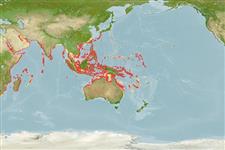Hexacorallia |
Scleractinia |
Plerogyridae
Environment: milieu / climate zone / depth range / distribution range
Ecology
Reef-associated; depth range 0 - 40 m (Ref. 848). Tropical; 31°N - 34°S, 26°E - 176°E (Ref. 848)
Indo-Pacific: widespread in East Africa including the Red Sea to New Caledonia, north to Ryukyu Islands, south to Great Barrier Reef, Australia.
Length at first maturity / Size / Weight / Age
Maturity: Lm ? range ? - ? cm
Formation: phaceloid to plocoid, with few to numerous corallites. Corallites are less than 7 mm diameter. Septa: mostly in two cycles, with only the first reaching the columella; primary septa may be exsert. Poorly developed columellae. Mantles extend during the day and may form a continuous surface obscuring the underlying growth-form. Color: commonly dark red with obvious green oral discs, also pink, orange, brown or uniform dark grey with white margins to primary septa (Ref. 848).
Occurs in reef environments where water is turbid (Ref. 848). Also in deep, steep slopes and crevices (Ref. 98471).
Life cycle and mating behavior
Maturity | Reproduction | Spawning | Eggs | Fecundity | Larvae
Members of the class Anthozoa are either gonochoric or hermaphroditic. Mature gametes are shed into the coelenteron and spawned through the mouth. Life cycle: The zygote develops into a planktonic planula larva. Metamorphosis begins with early morphogenesis of tentacles, septa and pharynx before larval settlement on the aboral end.
Veron, J.E.N. and G. Hodgson 1989 Annotated checklist of the hermatypic corals of the Philippines. Pacific Science 43:234-287. (Ref. 8817)
IUCN Red List Status
(Ref. 130435: Version 2025-1)
CITES status (Ref. 108899)
Not Evaluated
Threat to humans
Human uses
| FishSource |
Tools
More information
Trophic EcologyFood items (preys)
Diet composition
Food consumption
Predators
Population dynamicsGrowth
Max. ages / sizes
Length-weight rel.
Length-length rel.
Length-frequencies
Mass conversion
Abundance
Life cycleReproductionMaturityFecunditySpawningEggsEgg developmentLarvae PhysiologyOxygen consumption
Human RelatedStamps, coins, misc.
Internet sources
Estimates based on models
Preferred temperature
(Ref.
115969): 24.8 - 29.1, mean 28 (based on 1168 cells).
Price category
Unknown.
